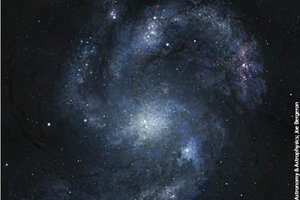Astronomers discover oldest spiral galaxy in the universe
The discovery with Hubble Space Telescope of a spiral galaxy, long before other galaxies are known to have formed, surprised scientists

An artist’s rendering of galaxy BX442 and its companion dwarf galaxy (upper left).
Joe Bergeron/Dunlap Institute for Astronomy & Astrophysics
Ancient starlight traveling for 10.7 billion years has brought a surprise – evidence of a spiral galaxy long before other spiral galaxies are known to have formed.
“As you go back in time to the early universe, galaxies look really strange, clumpy and irregular, not symmetric,” said Alice Shapley, a UCLA associate professor of physics and astronomy, and co-author of a study reported in today’s journal Nature. “The vast majority of old galaxies look like train wrecks. Our first thought was, why is this one so different, and so beautiful?”
Galaxies today come in a variety of unique shapes and sizes. Some, like our Milky Way Galaxy, are rotating disks of stars and gas called spiral galaxies. Other galaxies, called elliptical galaxies, resemble giant orbs of older reddish stars moving in random directions. Then there are a host of smaller irregular shaped galaxies bound together by gravity but lacking in any visible structure. A great, diverse population of these types of irregular galaxies dominated the early Universe, says Shapely.
RELATED: Are you scientifically literate? Take our quiz!
Light from this incredibly distant spiral galaxy, traveling at nearly six trillion miles per year, took 10.7 billion years to reach Earth; just 3 billion years after the Universe was created in an event called the Big Bang.
According to a press release from UCLA, astronomers used the sharp eyes of the Hubble Space Telescope to spy on 300 very distant galaxies in the early Universe. The scientists originally thought their galaxy, one of the most massive in their survey going by the unglamorous name of BX442, was an illusion, perhaps two galaxies superimposed on each other.
“The fact that this galaxy exists is astounding,” said David Law, lead author of the study and Dunlap Institute postdoctoral fellow at the University of Toronto’s Dunlap Institute for Astronomy & Astrophysics. “Current wisdom holds that such ‘grand-design’ spiral galaxies simply didn’t exist at such an early time in the history of the universe.” A ‘grand design’ galaxy has prominent, well-formed spiral arms.
To understand their image further, astronomers used a unique, state-of-the-art instrument called the OSIRIS spectrograph at the W.M. Keck Observatory atop Hawaii’s dormant Mauna Kea volcano. The instrument, built by UCLA professor James Larkin, allowed them to study light from about 3,600 locations in and around BX442. This spectra gave them the clues they needed to show they were indeed looking at a single, rotating spiral galaxy.
While spiral galaxies are abundant throughout the current cosmos, that wasn’t always the case. Spiral galaxies in the early Universe were rare because of frequent interactions. “BX442 looks like a nearby galaxy, but in the early universe, galaxies were colliding together much more frequently,” says Shapely. “Gas was raining in from the intergalactic medium and feeding stars that were being formed at a much more rapid rate than they are today; black holes grew at a much more rapid rate as well. The universe today is boring compared to this early time.”
Shapely and Law think the gravitational tug-of-war between a dwarf galaxy companion and BX442 may be responsible for it’s futuristic look. The companion appears as just a small blob in their image. Computer simulations conducted by Charlotte Christensen, a postdoctoral student at the University of Arizona and co-author of the paper, lends evidence to this idea. Eventually, BX442 and the smaller galaxy likely will merge.
Shapley said BX442 represents a link between early galaxies that are much more turbulent and the rotating spiral galaxies that we see around us. “Indeed, this galaxy may highlight the importance of merger interactions at any cosmic epoch in creating grand design spiral structure,” she said.
Studying BX442 is likely to help astronomers understand how spiral galaxies like the Milky Way form, she added.

